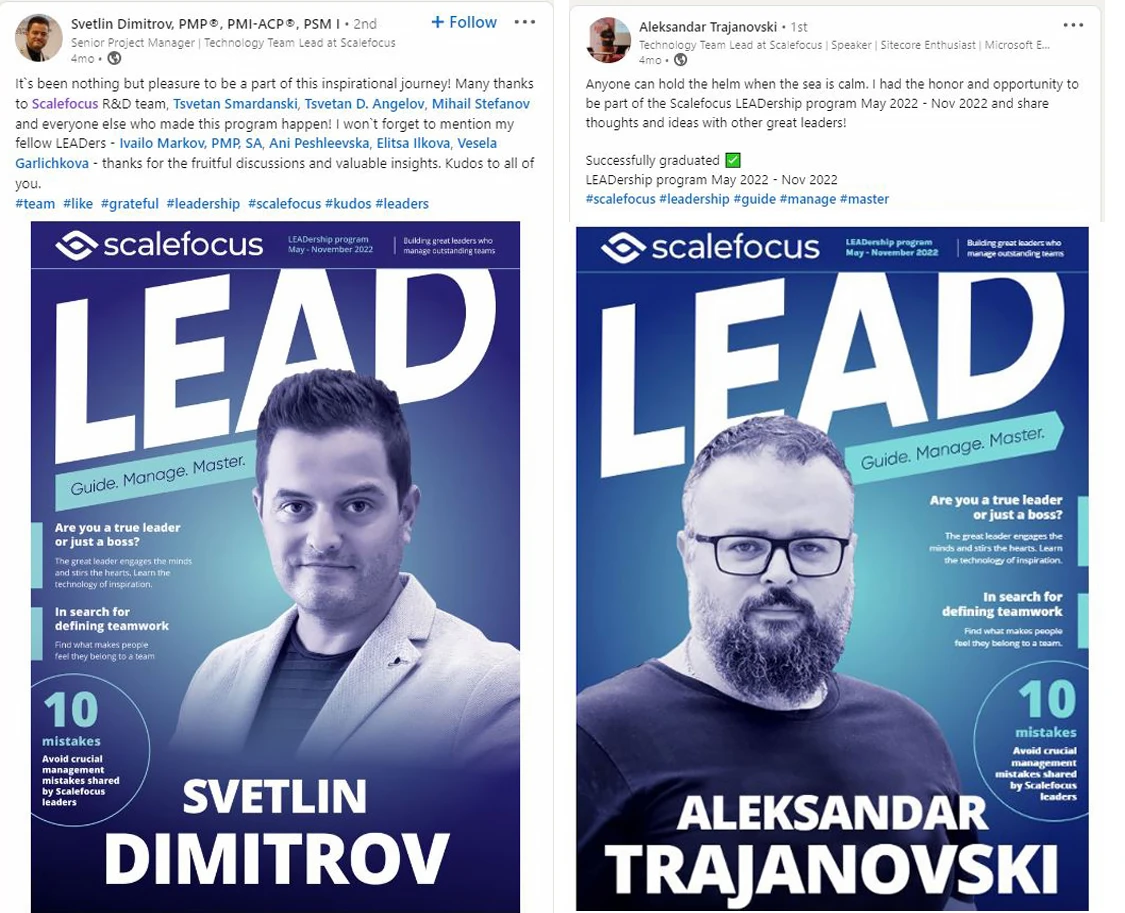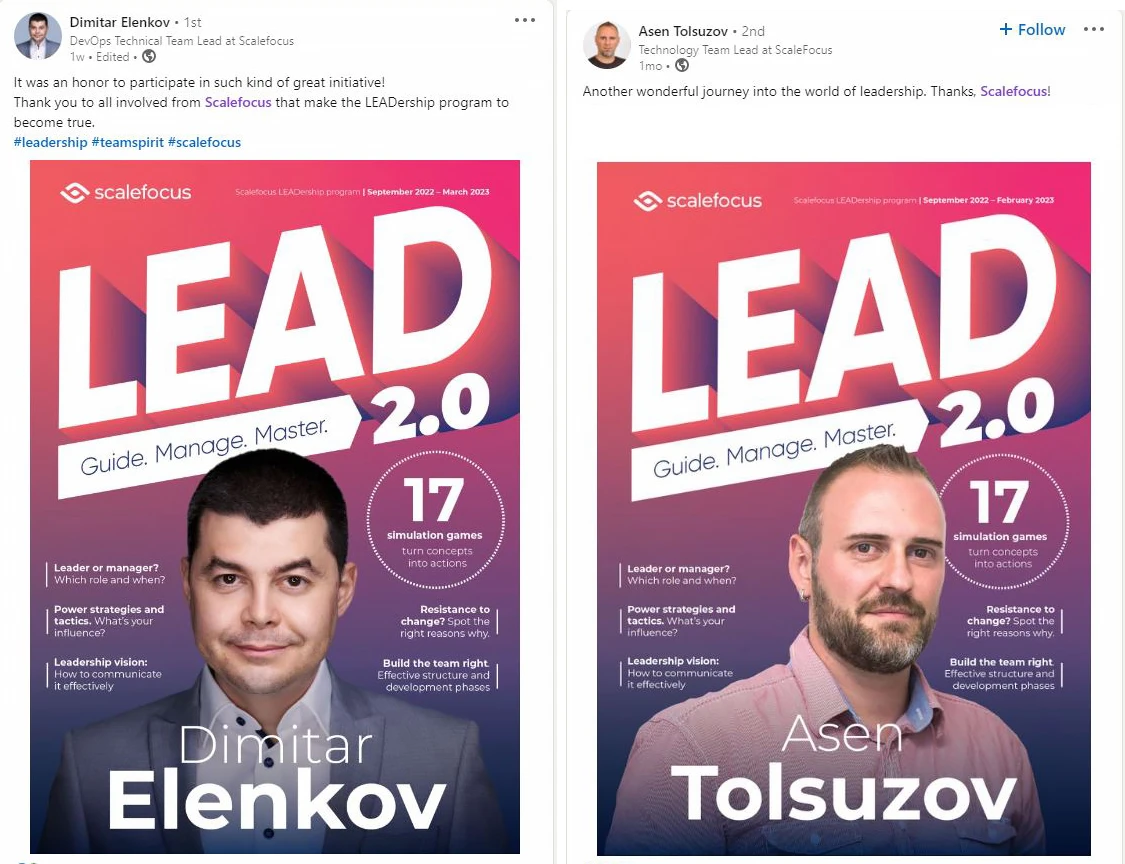Tsvetan Angelov, Learning and Development Manager at Scalefocus, shared details about the specifics and methods for training and developing people in the organization.

Tsvetan, tell us more about yourself and your role
I am passionate about helping organizations achieve their goals through effective learning programs and talent development initiatives. With a focus on assessment interpretation and training, I have delivered exceptional results for organizations across multiple industries.
My approach to developing high-performing teams and maximizing organizational effectiveness is strategic and collaborative. Throughout my career, I have successfully created and implemented L&D programs, facilitated training sessions, and led performance management and talent development initiatives.
At Scalefocus, I am responsible for the overall learning strategy in the company, for creating diverse training opportunities for our colleagues. This entails ensuring the availability of multiple tools and platforms, while also providing support to people and their leaders in crafting development mechanisms and programs.
I am also a certified trainer myself. I hold certifications in Hogan Assessment: Associate Trainer, Group-Dynamic Training & Training for Experts at an Assessment Center.
I frequently assume the role of a training leader and of an internal consultant, who is actively involved in developing various solutions aimed at supporting the growth of individuals in the company. I like to be close to the colleagues whose training I am responsible for. I strive to break any barriers between us, and and to maintain open communication with anyone who seeks advice on their development at Scalefocus.
How does your organization identify employees’ learning and development needs?
In recent years, we have been focused on developing, evolving, and consistently improving our training processes to ensure the timely upgrade of our colleagues’ skills. What sets our company apart is that, in addition to offering standard trainings for technical skills development, we also implement various interesting and structured programs that foster personal and professional growth of our team members. At Scalefocus, the Training and Development team is highly dedicated to the growth of our software engineers. When crafting their training programs, we actively seek innovative approaches, explore preferred learning methods, and incorporate models such as the “T-shaped development model.”
Let’s briefly explain the specifics of the “I-shaped vs T-shaped” model: The I-shaped theory refers to specialists in a particular area, who accumulate technical expertise to advance their careers. On the other hand, the T-shaped model encompasses broader technical skills and the ability to collaborate with others, to understand how teams function, to manage relationships, to and achieve collective results. This approach emphasizes the development of soft skills, such as leadership and communication, which can assist individuals in progressing and taking on more responsible or senior roles.

What examples of training programs has your organization implemented to help employees acquire new skills and advance their careers?
In the past two years, we have successfully implemented several structured programs to support our colleagues’ development. The most prominent of them are the “EXPLORE” and “LEAD SERIES”.
“EXPLORE” is a program related to enhancing skills that support individuals in their development according to the T-shaped model mentioned earlier. It aims to help us be more successful when collaborating with others, create an enjoyable work environment, and celebrate our achievements together.
As the name suggests, the “LEAD” Series is our flagship leadership development program as we truly believe in the importance of growing leaders from within Scalefocus.
I often receive questions like, “Why have a program? What are the benefits?” or “Structured elements —s houldn’t individuals choose how to develop specific skills?” My answer to these questions is straightforward: efficiency. The structured programs allow participants to delve deep into the subject matter, understand the logical connections between sub-topics, apply specific techniques, engage with people for whom this topic is relevant, and exchange ideas and experiences.
The programs we designed follow a structured path with various learning elements — many tailored to participants’ learning preferences. Ultimately, the goal is to develop and apply specific skills in practice effectively. Only then can we ensure that we provide meaningful and effective solutions for our colleagues.
Interestingly, depending on the objectives, one program could be more structured while another — more agile. In our case, EXPLORE is a program with a flexible methodology, while the LEAD series follows a more fixed structure.
Aa flexible development approach may sound abstract, so I will illustrate it with the EXPLORE program. It consists of numerous training modules or topics. The sequence or logic by which the learning path is built is entirely up to the participant — depending entirely on their current needs, goals, and the time they want to invest in learning. They choose where to start, which module to proceed with, etc. Additionally, in the EXPLORE program, some participants may only go through one module during a particular period, while others may go through several. What is important is that by the end of the program all participants develop the fundamental skills outlined in the T-shaped model, but each of them does that in their preferred way.
The LEAD Series, in contrast, is a highly structured leadership development program. Each participant starts their journey at point A and must pass through points B, C, and so on until the end. We approach the development of leaders in our organization with exceptional care and responsibility, as their role carries many responsibilities. Hence, the logic of the program is entirely focused on the need for topic progression, the value each subsequent topic adds to the previous one, and the necessity of establishing the correct logical coherence between them.
Check what our certified LEAD SERIES participants said about the experience


Tell us more about the elements of the programs?
The elements integrated into our programs result from the participants’ needs to develop specific skills, their personal preferences for learning methods, and the organization’s goals. What makes our programs successful is the richness of the elements used and, most importantly, their practical orientation.
All modules in our programs are built on bite-sized learning elements, also known as Microlearning. This approach provides exceptional flexibility for participants because they don’t have to treat learning as something separate which consumes a lot of time before it could be applied in practice. On the contrary, the goal is for participants to be able to apply what they have learned in their work as quickly as possible. Quality learning happens only when it moves beyond theory.
To ensure this bite-sized learning approach, we have incorporated multiple elements. Here are a few examples:
We cover the theoretical foundation through pre-recorded short videos from market experts, internal Subject Matter Experts (SMEs), or colleagues with extensive experience. This element provides significant flexibility, especially when people want to absorb specific information quickly. Another benefit is that everyone can tailor their learning based on their workload or personal preferences.
Of course, we have elements to assess the understanding of theory, but their purpose is to provide additional comprehension of the topic and support learning rather than solely validating knowledge.
Skills are developed only when a person can apply them in practice. Therefore, we have practical tasks that require the involvement of other colleagues. Often, the results from these serve as a means for self-reflection for participants, helping them assimilate the acquired skill and to connect it with real-life practice.
Another element is “Peer learning,” where we frequently include participant meetings led by subject-matter experts or senior leaders, whom we call hosts. They assist participants in connecting theory and results from practical exercises to real business scenarios. Colleagues often share that they find this to be one of the most valuable elements. It allows them to discuss their challenges, explore alternative approaches, or learn from the experience of the hosts.
We frequently use simulations where participants can immerse themselves in a safe environment, close to reality, and experiment with different behaviors to test the outcomes. This allows for actual skill development but without any real consequences for the participant or their team because we all know that making more mistakes is normal while learning.
Last but not least, we employ innovative approaches to stimulate group decision-making, quality discussions, in-depth exploration of topics, and experience sharing. We are early adopters of a platform that provides us with these innovative opportunities for group learning, especially in the virtual environment in which we all work. We are already seeing positive results from its implementation as an element in our programs.
How do you select the topics for the programs and pieces of training you offer?
The most important thing is to follow the needs of people within the context of our business operations. That’s why we researched the preferred learning styles and formats for our colleagues.
This gave us a clear understanding of their needs and allowed us to build complete training modules and programs, fundamentally aligned with them and tailored to develop their necessary skill sets.
We apply many best practices regarding the selection of topics:rely on various data sources, such as input from colleagues, the goals they set for themselves, feedback from existing training programs, research and focus groups, observations, career development discussions, and more. These sources provide valuable insights for determining our programs’ most relevant and impactful topics.
How do you measure the effectiveness of the training and development programs?
One element is crucial for the success of every program: the level of motivation each participant brings. For our programs, we have been observing a consistently growing engagement and interest by the participants with every new cohort.
Furthermore, we continue employing best practices such as post-training questionnaires or feedback from participants’ managers about how their performance has been impacted by a specific training. Change tends to take time, as skills need to be mastered but we are happy to observe positive development trends.
What is the most important thing you have learned about creating training and development programs?
When you actively listen to the needs of participants and proactively create learning opportunities tailored to their needs, it is only a matter of time before you see positive results. In short, the question is “when” and not “if.”



